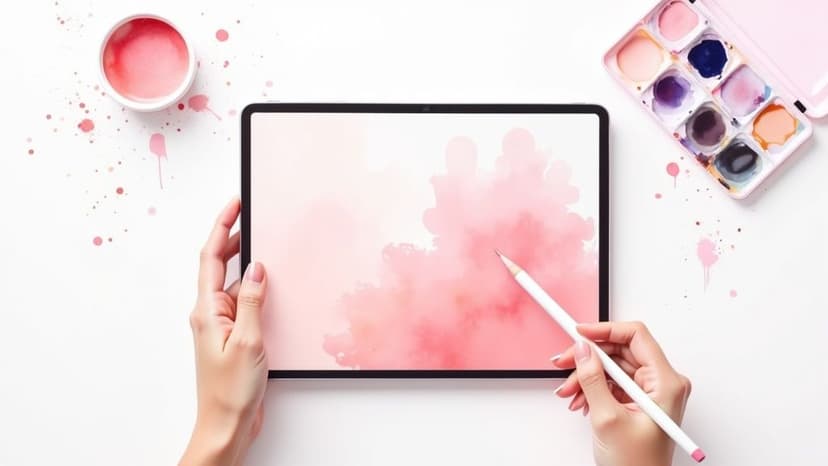
Create a Perfect Pastel Pink Background with AI
Learn to generate any pastel pink background you can imagine. This guide covers easy AI prompts, expert tips, and creative ideas to master your designs.
Discover how a fashion illustration template can transform your design workflow. Learn to choose, use, and elevate templates with AI for professional results.

Instastock Team
November 5, 2025 • 10 min read
Ever found yourself with a brilliant design idea, only to get stuck trying to draw the perfect human figure to put it on? That's exactly where a fashion illustration template comes in.
Think of it as your personal digital mannequin. It’s a pre-drawn figure, often called a croquis in the industry, that gives you a perfectly proportioned base to start sketching your clothing designs immediately. No more wrestling with anatomy—you can jump straight into the fun part.
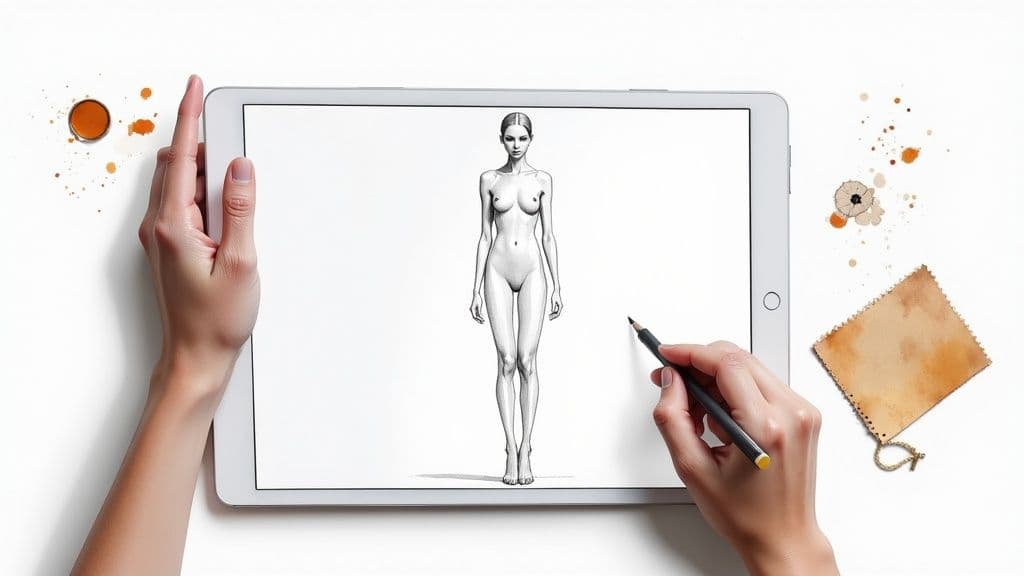
At its heart, a fashion illustration template is a designer’s best friend for streamlining the creative process. It handles the heavy lifting of getting the body proportions right, freeing you up to pour all your energy into the garment itself—the silhouette, the drape of the fabric, the tiny details that make it unique. This is how designers ensure every piece in a collection looks uniform and professional.
Before we get too far into the weeds with templates, it helps to have a grasp of the broader art of fashion illustration. Think of the template as the canvas and your design as the masterpiece you paint on it.
Using templates is hardly a new trick. In fact, it has a rich history. Renowned British couturiers like Victor Stiebel relied on them back in the mid-20th century to sketch out entire seasonal collections long before fashion photography dominated magazines. It was all about speed and consistency, which was vital for getting designs to manufacturers quickly.
Today, these templates are indispensable for designers of all levels, and they really boil down to three key benefits:
A template doesn't limit your creativity—it liberates it. It provides the structure so you can focus on building your unique vision without distraction.
To give you a better idea of what’s out there, templates come in all shapes and sizes, each suited for a different purpose.
Here's a quick look at the most common templates and what they're used for.
| Template Type | Best For | Key Feature |
|---|---|---|
| Technical Flats | Production specs, pattern making | A flat, 2D view showing seams, stitches, and construction details. |
| Posed Croquis | Lookbooks, portfolio presentations | Dynamic poses that showcase a garment's movement and style. |
| Kidswear Templates | Designing children's clothing lines | Proportioned specifically for different age groups (toddlers, kids, teens). |
| Plus-Size Templates | Inclusive fashion design | Realistic and diverse body shapes for designing plus-size collections. |
| Maternity Templates | Designing for expectant mothers | Figures that realistically represent the proportions of pregnancy. |
Whether you need a static pose for a technical drawing or a dynamic runway strut to show off a flowing gown, there’s a template out there to match your vision. They're a foundational tool that helps bring any design to life.
Right then, let's talk about why templates are the secret weapon hiding in plain sight in every savvy fashion designer's toolkit.
Think of a fashion illustration template less like a shortcut and more like a launchpad for your creativity. Top designers are constantly battling the clock, trying to get ideas down before that spark of inspiration vanishes. They can't afford to get bogged down in the basics, and that's precisely where a good template comes in.
Instead of spending precious time meticulously sketching a figure, you can dive straight into the fun part: the design. This speed is an absolute game-changer. It means you can try out several versions of an idea in the time it would have taken you to draw just one figure from scratch, closing the gap between a fleeting thought and a design you can actually see.
It's not just about speed, though. Templates give your work a solid, professional consistency that's tough to achieve otherwise. When you're pulling a collection together, you want every single piece to feel like it belongs. Using the same croquis for each sketch ensures all your garments are shown with the same polished, perfect proportions.
This kind of uniformity is crucial when you're creating lookbooks, building your portfolio, or putting together a presentation. It helps you tell a clear, cohesive story and shows anyone looking at your work that you've thought about every last detail.
By standardising the figure, you’re not making the designs generic; you’re creating a consistent canvas that makes your unique creative voice shine even brighter.
Maybe the biggest win is the sheer mental freedom a fashion illustration template gives you. Let's be honest, drawing the human form correctly takes a lot of skill and concentration. By letting a template handle that part, you're saving your most important resource: your creative energy.
All that brainpower can be poured directly into the design itself—getting the silhouette just right, playing with fabric textures, or dreaming up the little details that will make your work stand out. This is especially important in the UK, where a staggering 64% of fashion brands ramped up their spending on visual design between 2020 and 2023 to make an impact online. You can take a deeper dive into the history of fashion in the UK on FutureLearn.
At the end of the day, a template takes care of the science of proportion, leaving you free to master the art of fashion.
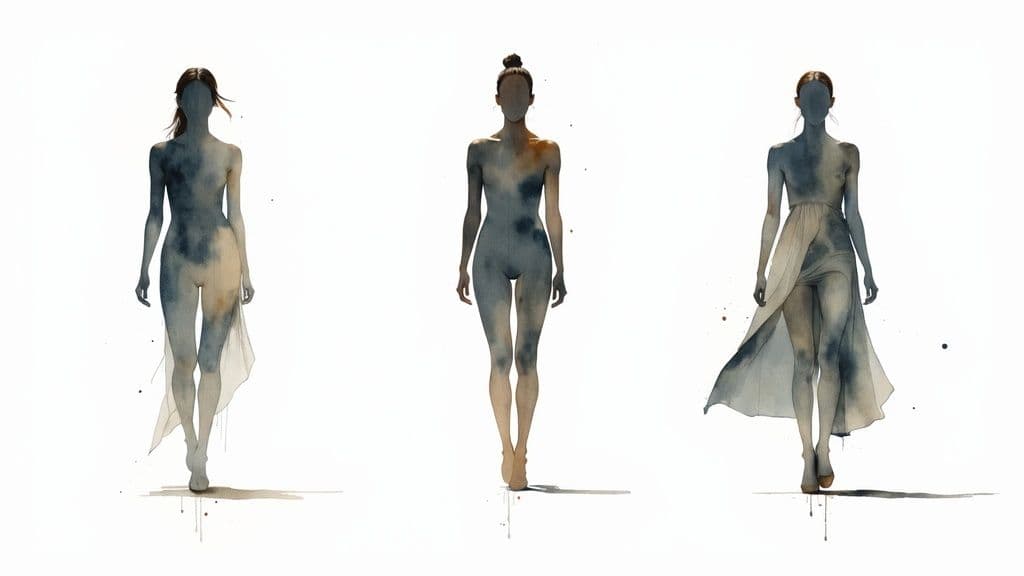
Picking the perfect fashion illustration template is a bit like a tailor choosing the right mannequin—it has to be the perfect fit for your vision. The first thing to think about is who you're designing for. Are you sketching out a menswear collection, a plus-size line, or chic womenswear? Each one needs a croquis with the right proportions to make sure the final garment looks and fits just right.
Next, consider the story you're trying to tell with your design. A dynamic, walking pose is brilliant for showing off the movement of a flowing gown. On the other hand, a simple, static pose works much better for technical flats where every seam and stitch needs to be crystal clear. The pose you choose sets the mood and brings your illustration to life.
The look and feel of the template itself is a huge part of the puzzle. Some designers lean towards minimalist, stylised figures that really let the clothing take centre stage. Others might go for a more realistic template to show exactly how fabric drapes on a human form. It all comes down to your personal taste and the identity of your brand.
You also need to think about how you like to work. Do you love the tactile feel of a pencil on paper, or do you prefer the endless possibilities of a digital canvas?
The best template isn't just a foundation—it's a partner in your creative process. It should feel intuitive and make it easier, not harder, to bring your ideas to life.
Still on the fence about which format fits your workflow best? This quick comparison should help clear things up.
| Feature | Digital Templates | Printable Templates |
|---|---|---|
| Flexibility | You can easily scale, edit, and layer them in apps like Procreate. | They're a fixed size but perfect for using traditional media like pencils or markers. |
| Speed | Fantastic for brainstorming ideas and creating lots of versions quickly. | Ideal for designers who love a hands-on, tangible sketching process. |
| Integration | They slot perfectly into digital design and presentation workflows. | You'll need to scan them to get them into a digital portfolio or share them online. |
Ultimately, choosing a great base sets the stage for a strong final design. It’s a foundational step, just like creating clear project goals when you put together effective design brief templates.
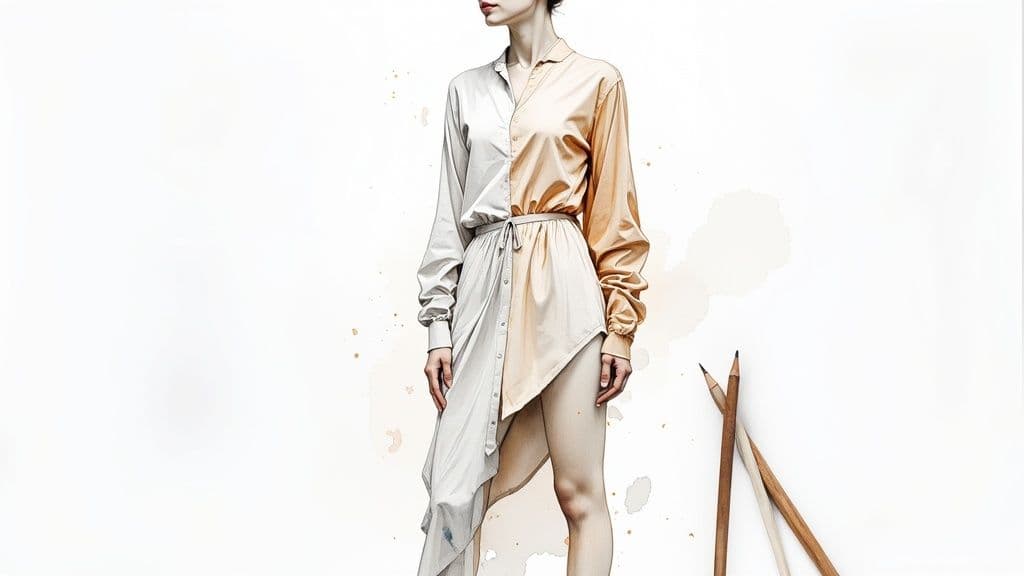
This screenshot from Adobe Illustrator gives you a great behind-the-scenes look at how a digital fashion illustration template acts as the skeleton for a detailed design. Once you have this base figure sorted, you can pour all your energy into crafting the patterns and shapes that make your collection unique.
Okay, so you’ve got your template. Now for the fun part. The easiest way to think about it is to see the pre-drawn figure (the croquis) as your mannequin. Your design is the fabric you’re about to drape over it. It’s a beautifully simple process, whether you’re a traditional sketcher or a digital whiz.
If you love the feel of pen on paper, just lay a sheet of tracing paper over your printed template. A lightbox is ideal, but taping it to a sunny window works a treat. You’ll see the figure underneath, giving you the perfect guide to draw your garment on top. For the digital crowd using tools like Procreate or Illustrator, just pop the template on its own layer and start sketching on a fresh layer above it.
As you draw, really think about how your chosen fabric would actually hang and move on a person. Is it a stiff, heavy denim that creates sharp, angular folds? Or is it a slinky silk that would cling and flow with every curve? The pose of the template is your best friend here—it shows you exactly where the material would naturally bunch up at the elbows and knees, pull tight across the shoulders, or hang free.
This is where the magic really happens. You’re not just drawing a flat picture of a dress; you’re capturing how that specific garment comes to life on a real body. If this is new territory for you, it’s worth learning a bit more about how to create mockups that give your designs that realistic edge.
A fashion illustration template isn't just a body outline. It's a dynamic stage that lets you show off the weight, texture, and movement of the fabrics you’ve imagined.
Remember, a template is a launchpad, not a straitjacket. The real flair comes from making it your own, so don't be afraid to experiment and break the mould to fit your vision.
Making these small adjustments is how you turn a standard figure into something that screams your brand. The template stops being a rigid guide and becomes a flexible partner in your creative process.
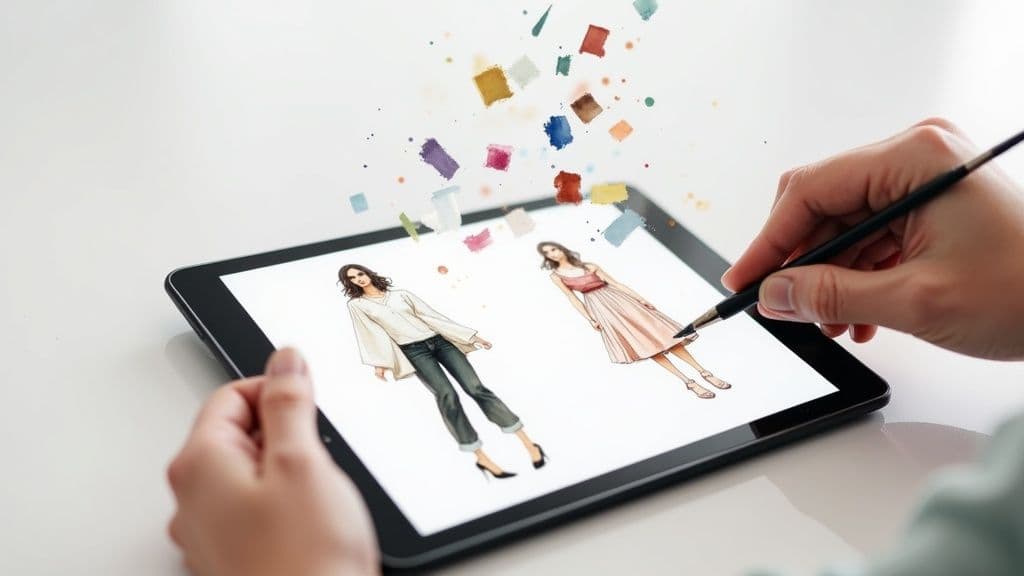
Okay, let's get into how artificial intelligence is completely changing the game for fashion design. Picture this: you've just sketched a simple dress using your go-to fashion illustration template. Now, what if you could instantly see that exact design in dozens of different fabrics, colours, or patterns without having to redraw a single line? That’s precisely what AI tools bring to the table.
With just a few simple text prompts, you can direct an AI to flesh out your vision. Think of commands like, 'render this skirt in plaid wool' or 'show these trousers in a vintage denim wash'. In seconds, you get photorealistic variations. This isn't about the AI taking over your job; it's about giving your creativity a seriously powerful sidekick.
Think of AI as your own personal, lightning-fast design assistant. It’s perfect for whipping up quick prototypes and exploring concepts that would otherwise take hours to illustrate by hand. Forget spending ages manually colouring and texturing every single variation. You can now cycle through countless ideas, helping you nail down your final look in a fraction of the time.
This tech gives you the freedom to experiment with really bold ideas without the massive time commitment. Ever wondered how a floral pattern might clash (or brilliantly combine) with a geometric one? Or wanted to test a dozen shades of blue for a spring collection? AI makes this kind of visual brainstorming feel instant and effortless. Our guide on how to generate images with AI is a fantastic place to start if you want to get the hang of it.
AI doesn’t just speed up your work—it expands your creative horizons. It takes care of the repetitive, tedious stuff, leaving you free to focus on the truly innovative ideas that make your brand stand out.
If you want to take your designs even further, you can explore more specialised tools like embroidery and lettering software with built-in templates. Pulling these kinds of digital tools into your process creates a smooth path from that first spark of an idea to a detailed, production-ready design, all while keeping your creative vision right at the centre of it all.
Right, let's take a look at the timeless art of fashion illustration and see where today's digital tools fit in.
To really get why a modern fashion illustration template is so useful, it helps to glance back at the art form’s glamorous past. Long before photography became the go-to for magazines like Vogue, it was fashion illustrators who were the real trendsetters, shaping what we wore with just ink and watercolour.
These artists were brilliant storytellers. They didn't just sketch clothes; they captured the whole vibe of a garment—its feel, the way it moved, and the mood it evoked. A talented illustrator could bring the whisper of silk or the heavy drape of wool to life in a way a photograph couldn't, giving couture a real personality.
Here in the UK, this history is particularly rich. Throughout the 1950s, dreamy, pastel illustrations were all over magazines like Tatler and The Sketch, perfectly capturing the texture of different fabrics. But as photography started offering a more direct, hard-hitting feel, illustration slowly began to take a backseat by the early 1960s. You can dive deeper into this golden era of UK fashion illustration on FidaWorldwide.
Knowing this history helps us see today's digital tools not as a replacement for artistry, but as the next step in its journey.
Think of a template not as a shortcut that skips over tradition, but as a modern continuation of it. It’s simply the latest tool in a long history of artists finding new ways to bring their visions to life, blending the elegance of the past with the incredible speed of today.
It’s completely normal to have a few questions before you jump in and start using a new creative tool. Let's tackle some of the things that designers often wonder about when it comes to fashion illustration templates.
Absolutely, yes. Think of the template as just the starting point—the actual garment design you create on top of it is your own unique intellectual property.
One thing to keep in mind, though, is to always double-check the license of the template you're using. Most will give you the green light for full commercial use of your finished illustrations, but they won't let you turn around and resell the blank template itself.
Not a chance. In fact, many of the world's most famous designers use templates to keep their collections cohesive, but you'd never mistake their work for someone else's. Their signature style always shines through.
A template is just the canvas; it’s your unique design, your rendering style, and all your creative flourishes that truly bring the piece to life. It's all about how you make it your own.
Ready to see just how unique your ideas can look? Instastock gives you AI-powered tools to take your template sketches and spin them into endless visual variations in a matter of seconds. Start creating for free today at instastock.studio.

Learn to generate any pastel pink background you can imagine. This guide covers easy AI prompts, expert tips, and creative ideas to master your designs.
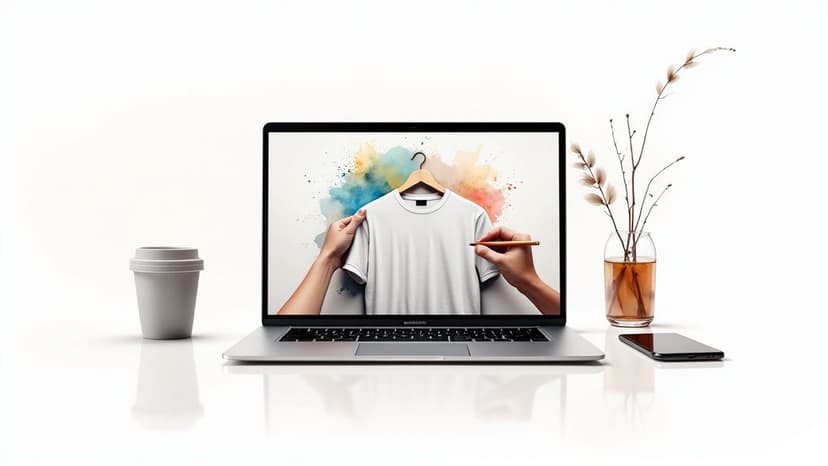
Learn how to create mockups that win projects. This guide covers planning, tool selection, and presentation tips for designers.
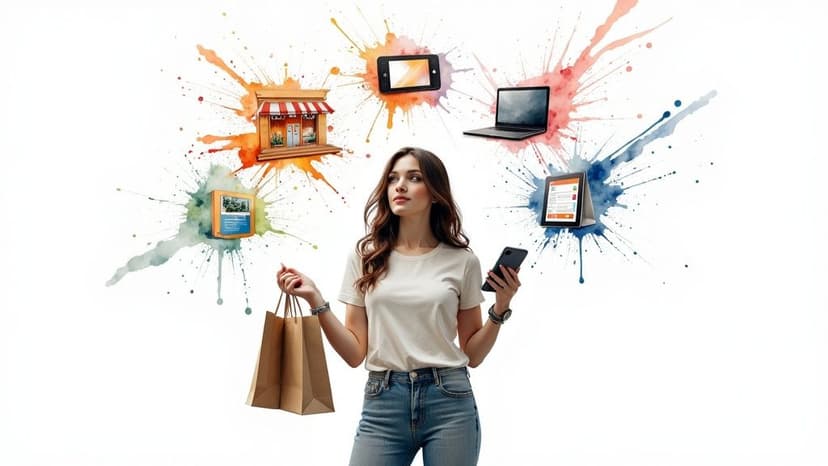
What is omnichannel marketing? Learn how to build a seamless customer experience that drives loyalty and growth for your UK business with this practical guide.